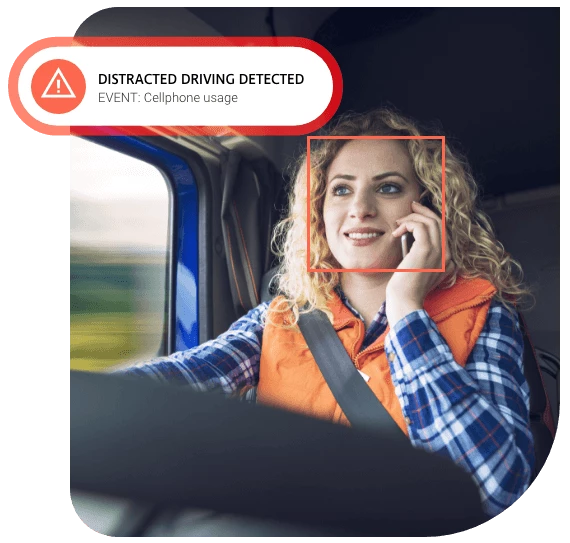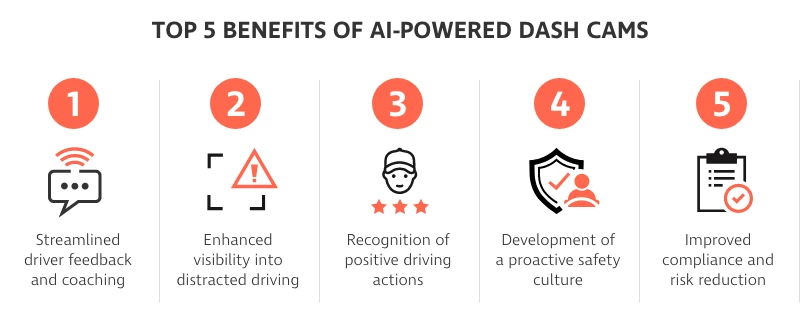Key Takeaways
Distracted driving is a leading cause of road accidents, creating serious safety risks for drivers, fleet operators, and the public. Studies show that 70% of fleet managers have experienced the effects of distracted driving incidents, with mobile phone use cited as the primary cause.
AI-powered dashcams transform fleet safety by proactively identifying distracted driving behaviours, providing real-time alerts that equip fleet managers with actionable insights. With AI camera technology, fleets can prevent accidents before they happen, reduce operational risks, and improve driver safety.
Table of Contents
- The Difference Between AI and Non-AI Cameras
- Advances in AI Camera Technology
- Top-5 Benefits of AI-Powered Dash Cams
- The Future of AI in Fleet Safety
- Prepare for the Future of Distracted Driving Prevention
The Difference Between AI and Non-AI Cameras
AI-powered cameras like the IQ Camera and Smart Dashcam are improving fleet management capabilities by going beyond simple video recording. By converting driving actions into actionable data, AI cameras empower fleet managers to improve safety, streamline coaching, and develop a proactive safety culture.
Understanding Driving Behaviour Through AI
Unlike traditional dashcams that only record video footage, AI-powered cameras analyse driver behaviour in real-time. By leveraging machine learning and computer vision, AI cameras can detect signs of distracted driving, such as mobile phone use, drowsiness, or taking hands off the wheel. This ability to understand driver behaviour allows fleets to take a proactive approach to safety rather than relying on reactive measures.
Turning Driver Actions into Actionable Data
AI cameras convert driving behaviours into data that fleet managers can use for coaching and performance improvement. These systems automatically flag unsafe actions, assign driver safety scores, and provide insights that help fleet managers implement targeted training programs. This level of intelligence is a significant leap from traditional cameras, which require manual video reviews and lack behavioural analysis capabilities.

Advances in AI Camera Technology
AI camera technology has made important strides in recent years, improving detection capabilities, expanding behavioural recognition, and integrating more seamlessly with existing applications. These advancements are transforming how fleets monitor and manage driver safety, providing a more comprehensive and proactive approach to preventing distracted driving.
Enhanced Accuracy and Detection
AI camera technology is becoming increasingly precise, with advanced algorithms that improve the detection of distracted driving behaviours. Modern AI cameras can distinguish between intentional movements and risky distractions, reducing false alerts and ensuring drivers receive relevant feedback.
Expanded Behaviour Recognition and Driver Rewards
Beyond identifying risky behaviours, AI cameras now recognise positive driving actions. These capabilities allow fleets to implement driver recognition programs that reward safe driving habits, helping to create a balanced feedback system that motivates drivers rather than just penalising mistakes.
Seamless Integration with Coaching Applications
The latest AI dashcams are designed to work seamlessly with coaching applications, providing real-time feedback to drivers through in-cab audio alerts, performance reporting and manager feedback. Fleet managers can use AI-generated reports to identify coaching opportunities and tailor training sessions based on actual driver performance data.
Improved Privacy Controls
To address driver concerns, AI dashcams now offer privacy-focused features, such as the ability to analyse driving behaviours without storing video footage. This ensures fleet managers can monitor safety without overstepping privacy boundaries, fostering a sense of trust among drivers.

Top 5 Benefits of AI-Powered Dash Cams
- Streamlined driver feedback and coaching. AI cameras provide real-time, in-cab alerts to help drivers correct unsafe behaviours instantly. Integrated coaching apps allow fleet managers to review data and offer targeted training without in-person ride-alongs.
- Enhanced visibility into distracted driving. AI cameras detect distractions that traditional telematics solutions miss, ensuring drivers remain focused. Fleets using AI cameras have seen significant reductions in distracted driving incidents, improving overall safety.
- Recognition of positive driving actions. AI technology identifies safe driving behaviours, such as defensive driving and collision avoidance. By recognising and rewarding positive actions, fleets can create a culture of engagement and improvement.
- Development of a proactive safety culture. Immediate feedback and data-driven insights encourage driver accountability and continuous safety improvements. This proactive approach reduces turnover and fosters a shared responsibility for safety.
- Improved compliance and risk reduction. AI cameras help fleets maintain compliance by continuously monitoring and documenting unsafe driving behaviours.
The Future of AI in Fleet Safety
Advancements in AI-driven telematics are transforming fleet safety. Predictive analytics, biometric monitoring, and seamless integration enhance accident prevention and compliance. AI enables data-driven decisions that improve driver safety and operational efficiency.
Predictive Accident Prevention
AI will become even better at forecasting potential accidents based on driving patterns and external conditions. By analysing vast amounts of data, AI-powered cameras can identify high-risk scenarios before they escalate, allowing for preventive actions that improve overall fleet safety.
Advanced Biometric Monitoring
Future AI systems will integrate with biometric sensors to detect driver stress levels, fatigue, and even medical emergencies. By continuously monitoring physiological indicators, these cameras will provide real-time alerts for drowsy or impaired driving, ensuring drivers remain attentive and responsive.
Deeper Telematics Integration
AI cameras will work alongside other fleet management technologies, such as autonomous emergency braking and adaptive cruise control, to create a fully connected safety ecosystem. This integration will allow for more seamless communication between different vehicle systems, enhancing overall driver safety and efficiency.
Compliance Automation
AI will play a larger role in regulatory compliance, automatically logging safety violations and generating reports for fleet audits. By continuously monitoring driver behaviour and documenting incidents, AI-powered cameras will help fleets adhere to industry regulations while reducing administrative burdens.
Enhance Safety with Video Telematics
Gain real-time visibility into driver behaviour and improve safety by utilising a video telematics solution. Ensure accountability, reduce incidents, and protect your drivers and assets.
Prepare for the Future of Distracted Driving Prevention
As AI technology advances, fleet operators who invest in smart camera solutions now will be better positioned to prevent accidents, protect drivers, and optimise their operations in the coming years. Now is the time for fleets to harness the power of AI and take distracted driving prevention to the next level.
For more information about AI-powered telematics and fleet management software, contact our team today.

